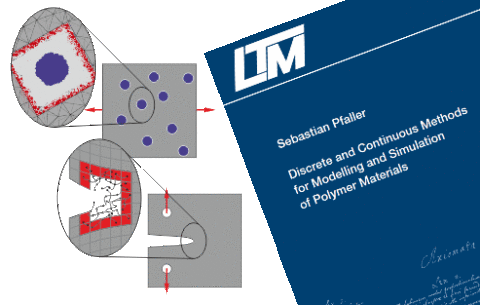Habilitation thesis published
After preparing the monograph for printing, Sebastian Pfaller’s habilitation thesis is available both in online format and as a hard copy. The digital version can be downloaded at https://doi.org/10.25593/opus4-fau-18036. The thesis summarizes the recent research activities of our group and reflects them in a unified perspective. This includes the enhancement of the Capriccio method [1] and its extension to large strains [2] using the VEVP model [3]. Furthermore, Sebastian Pfaller illustrates how continuum mechanical constitutive laws can be calibrated using molecular dynamics pseudo-experiments [4], which poses a challenge especially for highly inelastic materials [3]. Finally, the investigation of interphase properties in polymer nanocomposites [5] is presented as a relevant application of the Capriccio method.
–
[1] Pfaller, S.; Kergaßner, A. & Steinmann, P., “Optimisation of the Capriccio Method to Couple Particle- and Continuum-Based Simulations of Polymers” , Multiscale Science and Engineering, 2019, 1, 318-333.
[2] Zhao, W.; Ries, M.; Steinmann, P. & Pfaller, S., “A viscoelastic-viscoplastic constitutive model for glassy polymers informed by molecular dynamics simulations”, International Journal of Solids and Structures, 2021, 111071.
[3] Zhao, W.; Steinmann, P. & Pfaller, S., “A particle-continuum coupling method for multiscale simulations of viscoelastic–viscoplastic amorphous glassy polymers”, International Journal for Numerical Methods in Engineering, 2021, 122, 7431-7451.
[4] Ries, M.; Possart, G.; Steinmann, P. & Pfaller, S., “Extensive CGMD Simulations of Atactic PS Providing Pseudo Experimental Data to Calibrate Nonlinear Inelastic Continuum Mechanical Constitutive Laws”, Polymers, Multidisciplinary Digital Publishing Institute, 2019, 11, 1824.
[5] Ries, M.; Possart, G.; Steinmann, P. & Pfaller, S., “A coupled MD-FE methodology to characterize mechanical interphases in polymeric nanocomposites”, International Journal of Mechanical Sciences, Elsevier, 2021, 106564.

